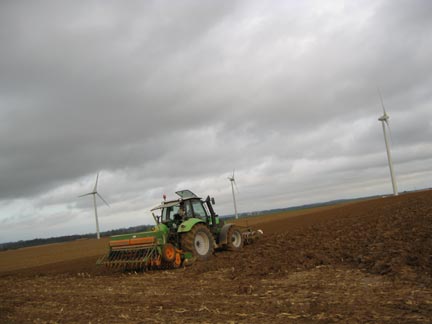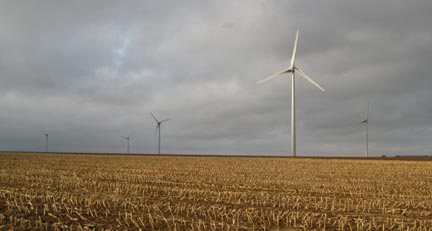Global Climate Change - France
Wind whisking for a better world
by Alison Hird
Article published on the 2009-11-23 Latest update 2009-12-04 15:50 TU
France currently has 2,500 wind turbines. Wind power provides less than two per cent of the country’s electricity. But the 2007 Grenelle environment accords aim to increase that production by five times, increasing the number to 8,000.
Nicolas Wolff, head of the French wind syndicate (FEE), admits France is far behind its neighbours, Germany (23,000mw) and Spain (16,000MW), but explains that wind power is now the fastest growing renewable energy source in France and will greatly benefit the environment.
“Today we’re saving the CO2 emissions of about two million cars, just with our installed capacity [of 4,000MW]. Tomorrow, that’s to say in 2020, if we reach these 25,000MW, we would be saving the emissions of more than eight million cars. It’s a major saving.”
Since it produces none of the greenhouses gases linked to climate change, wind power is clean energy. But for it to be efficient those turbines have to turn. And that means wind, lots of it.The Pas de Calais area in northern France has plenty, and is now one of the main regions where wind power is being developed.
In Fruges, about 40km inland from the Normandy coast, 70 turbines have been installed on around 180,000 hectares of mainly agricultural land. It’s France’s biggest wind farm, supplying a potential of 140 mw.
“Enough to supply 150,000 homes with all their domestic electricity needs” says Matthieu Escaré, project developer with the German company Ostwind, which manages the wind farm.
Pointing to the steadily turning blades, Escaré says that while there are seasonal variations, “they produce electric power 80 per cent of the time”.
The fact the region is flat and close to the sea is also an advantage. “No mountains are stopping the wind so it’s very regular. A perfect area for producing wind energy.”
Close up, the turbines make surprisingly little noise. But they are big, 120-metres high, and a potential eyesore in this pretty rural landscape.
Jean-Marie Van Vooren, manager of the Ostwind office in Fruges, points out the area isn’t called “Pays des sept vallées” (the seven valleys) for nothing.
“Fruges itself and most of the surrounding villages are in the valleys […], reducing co-visibility,” he says.
So the people who see them most are the farmers on whose land the majority of the windmills are planted. They’ve become adept at driving their tractors around the huge turbines and get a healthy rent for their land - more than 6,000 euros per year for a 1,000m2 plot.
An elderly if sprightly farmer, Mr Liebessard, gets down from his tractor to explain that the two turbines on his fields of wheat bring in a bit less than that. But he has made friends with these tall white blades.
“The main thing is we’ve got good access roads now thanks to the turbines. Some people were against them but now they’re happy when a lorry can come and pick up tonnes of beetroot. Before, it was just a dirt track."
But when the wind blows in the wrong direction, the farmer says he can hear the turbines from his home in the neighbouring village about one km away.
Local mayor Jean-Jacques Hilmoine tells me he can’t hear them but sees the turbines from his living room window. Not the best of views, he admits, but a price well worth paying.
“The landscape’s changed but I think you have to accept that. [...]. The wind farm brings in 1.7 million euros per year in business tax and has allowed the town council to develop services including a nursery, cyber-centre, sports centre and medical centre that it couldn’t otherwise have afforded [...]. Wind power is just a tool for development.”
Not everyone shares his pragmatic view. The president of the Pas de Calais regional council is demanding a moratorium on plans to build further wind farms in the area, saying it’s ruining the landscape.
And there’s been limited but very vocal outcry against plans to develop a wind farm around 20kms from the historic Mont St Michel.
Jean Jacques Hilmoine admits development has to be done intelligently.
“We can’t have a handful of small wind farms spread all over the place. Better to have a few big ones where people feel the benefits”.
The benefits for local economies are clear but will wind power really help in the battle against climate change?
Even project developer Matthieu Escaré admits wind power is not a magic solution.
“Wind farm energy is not the only solution to stop climate change. We have also to develop other energies like solar, marine power. And above all reduce consumption.”
And there’s an awful lot of work to be done on that front. The French have increased their energy consumption by one per cent every year for the last decade.







